War stories are not always about tragedy or battle. Sometimes they’re not even about humans. Take, for instance, the story of a bald eagle named Old Abe. He lived amongst the troops for more than three years, became famous for his Civil War exploits, and died a hero. He is still remembered today and, although most people don’t know it, his legacy continues.
Like many war legends, Old Abe came from humble beginnings. He was captured in Wisconsin as an eaglet by a Chippewa man named Ahgamahwegezhig in the spring of 1861. The eaglet was taken on a trading expedition where he was sold to a local man who then sold it to a group of Civil War volunteers. They named the eagle Old Abe, after the president.
The volunteers were mustered into the 8th Wisconsin Volunteer Infantry Regiment, and Old Abe “was sworn into the United States service by putting around his neck ‘red, white and blue’ ribbons, and on his breast a rosette of the same colors,” according to an 1865 book about the eagle.
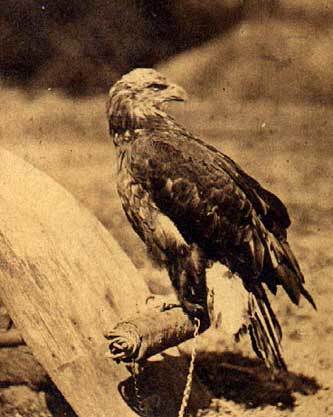 Old Abe when he became a member of the 8th Wisconsin. (Photo courtesy of Wisconsin Electronic Reader.)
Old Abe when he became a member of the 8th Wisconsin. (Photo courtesy of Wisconsin Electronic Reader.)
Old Abe went into battle many times with the soldiers who cared for him. The first of these was a minor engagement at Fredericktown, Mo. He accompanied the 8th Wisconsin for three years as they fought in the war’s Western Theater, at places like Corinth, Farmington, Vicksburg, Mansfield, and Pleasant Hill. The unit’s – and Old Abe’s – last action was on August 13, 1864, at Hurricane Creek.
Old Abe, sitting on a special shield-shaped perch, was carried into many of those battles along with the unit’s flags. He spread his wings and screeched at Farmington, encouraging the soldiers of his company in a battle that killed their captain.
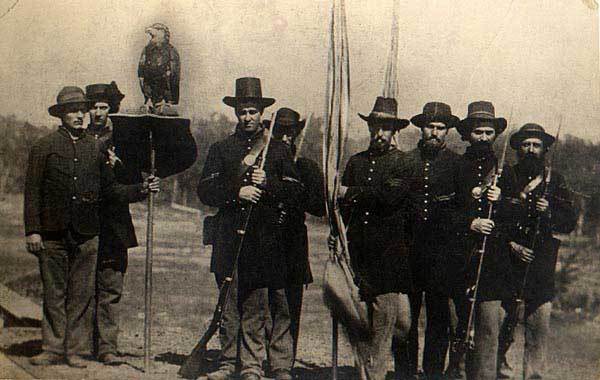 Old Abe with the color guard of his regiment at Vicksburg, Mississippi. (Wisconsin Electronic Reader.)
Old Abe with the color guard of his regiment at Vicksburg, Mississippi. (Wisconsin Electronic Reader.)
A widely reported (but possibly embellished) story of Old Abe occurred at the Battle of Corinth, where the cord holding Old Abe was cut. He flew away, first over the battle lines and then to the rear. Newspapers seized on the imagery of America’s symbol flying free over the battlefield, bringing more fame to the mascot, who was soon recovered by the 8th Wisconsin.
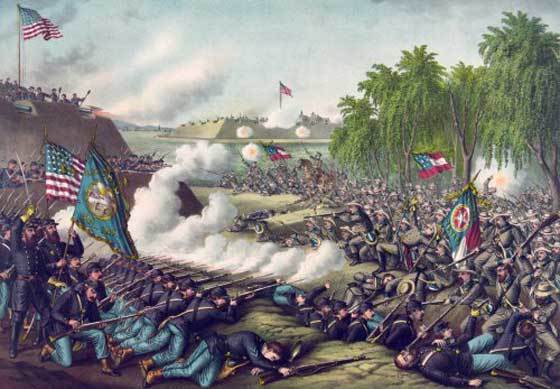 The Second Battle of Corinth, where Old Abe was reported to fly over the battle lines. (Library of Congress.)
The Second Battle of Corinth, where Old Abe was reported to fly over the battle lines. (Library of Congress.)
During the war, the 8th Wisconsin lost 59 men in combat during its service. Another 200-plus died of diseases, and a similar number were wounded. In all, nearly half its 1,200 men were casualties. The unit was mustered out in 1864, and its men decided to give Old Abe to the state of Wisconsin, where he was received with a hero’s welcome.
Old Abe was classified as a war relic by the state of Wisconsin, and the government created a special “Eagle Department” in the capitol building. Old Abe was granted a two-room living arrangement with a custom bathtub and a personal caretaker. He was a national celebrity and traveled across America to appear at events such as the 1876 Centennial Exhibition in Philadelphia and the 1865 Sanitary Fair in Chicago.
Wisconsin’s favorite bird died a hero. When a fire broke out in the capitol, Old Abe’s screeches alerted people and the fire was quickly put out. The eagle, however, was injured by the smoke and died in the arms of his caretaker on March 26, 1881.
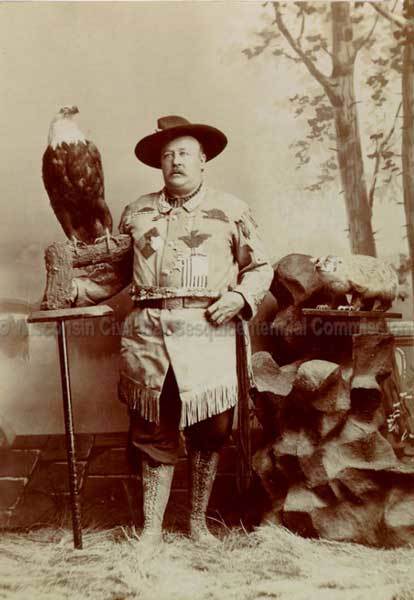 Old Abe with his last caretaker, George Gillies, who held Old Abe as the eagle took his last breaths. (Wisconsin Civil War Sesquicentennial Commission.)
Old Abe with his last caretaker, George Gillies, who held Old Abe as the eagle took his last breaths. (Wisconsin Civil War Sesquicentennial Commission.)
Old Abe’s legacy lives on. He is the mascot of multiple high schools. He appears on the Wisconsin monument at the Vicksburg battlefield and on a memorial arch at the University of Wisconsin. His most visible role, however, is as the symbol of the 101st Airborne Division of the United States Army, the “Screaming Eagles.” The 101st was created in the last days of World War I and then was reconstituted in Milwaukee in 1921. It celebrated its Wisconsin roots by adopting the eagle mascot that had been famous across America during the Civil War.
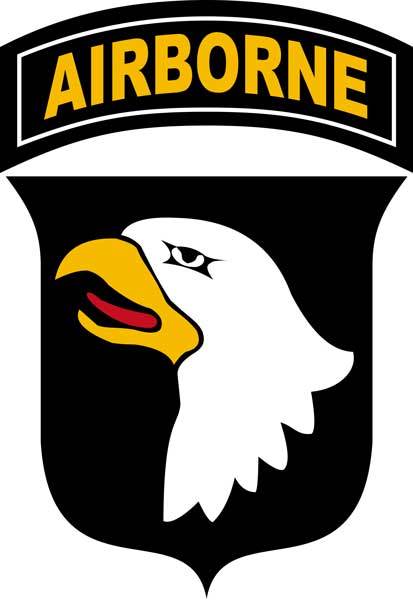 The insignia of the 101st Airborne Division carries the likeness of Old Abe.
The insignia of the 101st Airborne Division carries the likeness of Old Abe.
Old Abe was more than simply a pet for a band of young soldiers. He was a symbol of American endurance and sacrifice, and his likeness was used to raise money for good causes and to inspire the public. The Army has called him “the most famous animal mascot that ever served in the United States Army.” Although he died more than 125 years ago, he is still talked about and remembered fondly today, including at the Abraham Lincoln Presidential Library and Museum.
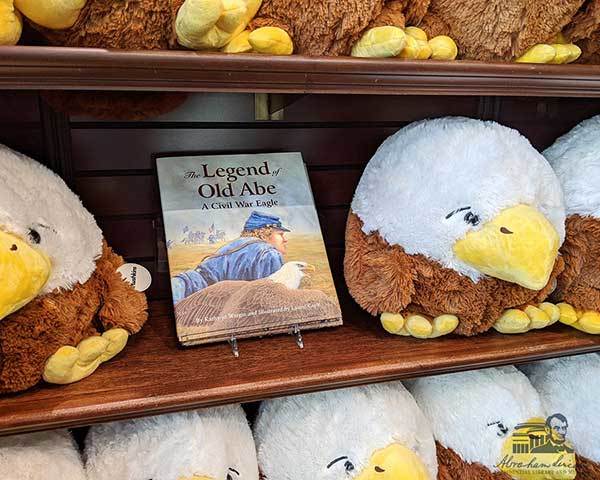 The memory of Old Abe lives on, including at the Abraham Lincoln Presidential Library and Museum, where visitors can get a book and stuffed toy of his likeness. (ALPLM.)
The memory of Old Abe lives on, including at the Abraham Lincoln Presidential Library and Museum, where visitors can get a book and stuffed toy of his likeness. (ALPLM.)
For those who wish to learn more about Old Abe, the best source is “History of ‘Old Abe,’ the Live War Eagle of the Eighth Regiment Wisconsin Volunteers” by Joseph O. Barrett, who was present at some of the events described: https://archive.org/details/historyofoldabel00barr
Other sources include:
By Nathan Cooper
ALPLM Communications Intern
Nathan Cooper is an intern at the Abraham Lincoln Presidential Library and Museum and a history student at the University of Illinois Springfield.